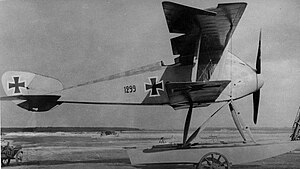The LTG FD 1 was a single-seat floatplane fighter built for the Imperial German Navy's (Kaiserliche Marine) Naval Air Service (Marine-Fliegerabteilung) by Luft Torpedo Gesellschaft (LTG) during World War I. Only six prototypes were built in 1917–1918 and are not known to have served on active duty.
| LTG FD 1 | |
|---|---|

| |
| Side view of the first prototype on beaching trolleys | |
| Role | Floatplane fighter |
| National origin | Germany |
| Manufacturer | Luft Torpedo Gesellschaft |
| First flight | 1917 |
| Status | Prototype |
| Primary user | Imperial German Navy |
| Number built | 6 |
Development and description
editLTG was founded in early 1915 to develop air-launched torpedoes and gradually expanded into sub-contracting aircraft components.[1] It received an order for three prototypes (Marine numbers 1299–1301) for a floatplane fighter on 8 February 1917[2] that used a 150-horsepower (110 kW) Benz Bz.III engine that drove the two-bladed propeller through a Loeb geared transmission.[3] The first airframe for static testing was delivered three months later and was destroyed during the process. The second aircraft was delivered in July, but flight testing showed it lacked maneuverability and longitudinal stability. As a result, the third prototype was sent back to the factory on 7 September. A version with conventional landing gear was tested at Johannisthal around this time.[4]
In March 1918, the aircraft passed its static testing, and another batch of three prototypes (Marine numbers 1518–1520) was made. However, due to necessary changes, such as enlarging the vertical stabilizer, deliveries were delayed until July. They were still undergoing testing when the war ended in November and are not known to have served on active duty.[5] When the Allies inspected the German seaplane bases in December, they recorded four surviving FD 1s at Hage. The fates of the FD 1s are unknown, but they were most likely scrapped.[6]
Specifications
editData from German Seaplanes of WWI: Sablatnig, Kaiserliche Werften, Lübeck-Travemünde, LTG, & Oertz: A Centennial Perspective on Great War Airplanes[1]
General characteristics
- Crew: 1
- Length: 9.0 m (29 ft 6 in)
- Wingspan: 10.0 m (32 ft 10 in)
- Height: 3.55 m (11 ft 8 in)
- Empty weight: 895 kg (1,973 lb)
- Gross weight: 1,165 kg (2,568 lb)
- Powerplant: 1 × Benz Bz.III , 110 kW (150 hp) Originally measured as 150 PS (110 kW)
Performance
- Maximum speed: 145 km/h (90 mph, 78 kn)
- Time to altitude: 1,000 m (3,300 ft) in 4 minutes, 30 seconds
Notes
editReferences
edit- Andersson, Lennart & Sanger, Ray (2014). Retribution and Recovery: German Aircraft and Aviation 1919 to 1922. Staplefield, UK: Air-Britain (Historians). ISBN 978-0-85130-467-0.
- Gray, Peter & Thetford, Owen (1987) [1970]. German Aircraft of the First World War (2nd ed.). London: Putnam. ISBN 0-85177-809-7.
- Green, William & Swanborough, Gordon (2001) [1994]. The Complete Book of Fighters: An Illustrated Encyclopedia of Every Fighter Built and Flown (Revised and Updated ed.). London: Salamander Books. ISBN 1-84065-269-1.
- Herris, Jack (2015). German Seaplanes of WWI: Sablatnig, Kaiserliche Werften, Lübeck-Travemünde, LTG, & Oertz: A Centennial Perspective on Great War Seaplanes. Great War Aviation Centennial Series. Vol. 15. n.p.: Aeronaut Books. ISBN 978-1-935881-27-8.